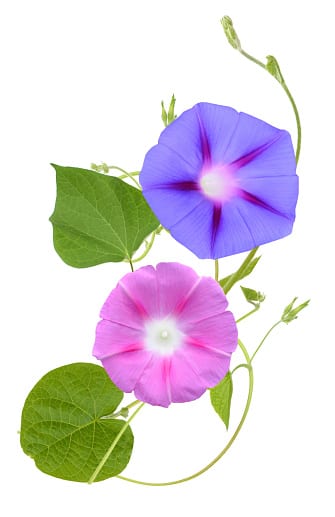
Moonflowers bloom at night and that is the reason for the romantic name. A few common Moonflowers include:
i. The evening primrose or Oenothera.
ii. Species of Ipomoea.
iii. Species of Mentzelia.
iv. Species of night-blooming Cereus.
v. Species of Datura.
Moonflowers can be grown in containers like pots to add grace and charm to an indoor garden or to decorate your driveway. There are a few simple factors to consider for growing moonflowers in containers.
The Color of the Moonflower
They are distinguished by their iridescent white petals but Moonflowers come in other colors too. Most common among the species have white flowers. The other colors are:
i. Yellow.
ii. Purple.
iii. Blue-green.
iv. Violet.
If you grow the plants near the porch or a patio, your nights will be filled with their enchanting and soothing aroma.
Why Aren’t Moonflowers Seen in Containers?
Moonflowers grow on vines that need support to climb.
Trellises or fences are commonly used to let the vines grow. Some people use a stake or another form of support inside the container to let the vines flourish. The necessity for an accessory deters many from growing Moonflowers in containers like pots.
Things Required to Successfully Grow Moonflowers in a Pot
Experienced Moonflower growers suggest using the below materials to grow Moonflowers in a container:
i. Common fertilizer.
ii. Pot.
iii. Potting mix.
iv. Grille or stake.
v. Moonflower seeds.
The containers are prepared in the same way as done for any other common flowering plant. Care must be taken to ensure that it has a proper drainage facility with the depth and height almost equal.
Planting the Seeds
The average size of the pot should be able to contain at least two gallons of soil. Use large pots to prevent them from tipping over due to the weight of the vines as they grow. After filling the containers with enough soil and fertilizer, position the support material like a stake or espalier inside the pot.
Tip: Pulling a wire from the periphery of the container to a nearby fence or another permanent erection is a clever ploy for growing moonflowers in containers.
Preparing the Seeds
Boil a bowl of water and put it aside for the steaming to subside. Throw the seeds into the hot water and let them soak overnight. Moonflower seeds have very hard coats. Due to this characteristic, germination takes time. Soaking in hot water softens the coat and the sprouts come out fast.
This coat softening process is called stratification. Some gardeners scrape the seeds with sandpaper or scratch with a small knife to reduce the thickness of the coat. These are also effective methods to speed up sprouting.
Sowing
For growing moonflowers in containers, the seeds should be pushed about a quarter of an inch to half an inch deep into the soil. The soil should have been prepared a day before and remained well-watered overnight. Seeds with softened coats will germinate in a span of seven to ten days.
The Best Time for Sowing
Experienced gardeners suggest sowing the seeds six to eight weeks before the spring frost. Covering the pots with a plastic wrap will aid in faster sprouting due to raised humidity levels. The ideal temperature is 750 F. Some people use a heating mat for seed starting beneath the tray- this is an optional process for growing moonflowers in containers.
Positioning the Containers
The pots should be stationed in such positions that receive good sunlight in the mornings and shade in the afternoons. Blooms will start to appear early due to the shading in the evenings.
Best Watering Practices
The soil should be maintained uniformly moist. The frequency for watering depends on the time taken for the topsoil to dry. Make sure to water only after the surface has properly dried out. This will encourage the healthy growth of roots.
When to Add Fertilizer
After planting the seeds, the frequency for fertilizing is once a month. Moonflowers need only half the quantity for other common flowering plants. Use only half of the recommended quantity printed on the fertilizer package. Excess fertilizers result in good growth of foliage with fewer flowers.
Tip: The average height of the Moonflower vines is six feet. In case, if they grow taller than six feet, snip off the new tips to arrest vertical growth for growing moonflowers in containers.
Safe Practices for Growing Moonflowers
The moonflower is a toxic plant. All parts, including its seeds, are poisonous. A variety called Ipomoea is deemed as noxious in a few states and its growing is banned.
Make sure that pets and children stay away from the plants. In the case of suspected toxic behavior immediately consult a physician.
Do not accidentally drop seeds on the soil. They can regenerate and can be a cause for concern if you live in a 9 to 11 hardiness zone as classified by USDA. A good practice is to remove any faded flowers before seeds take form.
Care for Moonflower Plants
Moonflowers are also prone to many diseases and attack by parasites. Here are some hazards faced by these plants and how to overcome the issues.
Black Rot in Warm and Humid Weather
The leaf margins will display yellowish V-shaped markings which will result in the leaves falling off.
Remedy: Grow the plants with enough space in between to allow good airflow. Do not work on wet plants to prevent the spread of black rot.

The Fungus Type Called Rust
They appear on the flowers as brown or reddish spots.
Remedy: Pull out the affected plants and throw them away at places from where the fungus can’t reach other plants.
Tip: Do not use the affected plants for compost. It will spread through the soil.
Stem Canker
If the stems of your Moonflower plants display sunken areas, it is a sure sign of the disease. Other symptoms include wilting or brown stems. The color or the affection will spread to the entire plant body resulting in death.
Remedy: Snip off affected stems or the entire plant if necessary. Discard them far away and do not use in compost. Take care to water only the soil and don’t get the plants wet.
Crop Rotation to Prevent Diseases
Experienced gardeners change the location of the plants for the next season. This helps in avoiding diseases.
Pests That Affect Moonflower Plants
There are many pests, some of them parasites that affect Moonflower plants. Here are five of the common pests and tips to take care of them.
Juice Sucking Aphids
Aphids use their antennae to drain the moisture from Moonflower plants. The process leaves a soupy residue on the stems and leaves that in turn attract ants. Aphids are insects that come in different colors like:
i. Red.
ii. Black.
iii. Green.
iv. Orange.
They are easily visible to the naked eye. If you spot them, spray them off with strong jets from your hose or use an insecticidal preparation.
Organic remedy: Bring in natural predators that eat aphids. They include wasps and lady beetles.
Leaf and Bud Eating Japanese Beetles
They eat all plant parts leaving only a skeleton of plant nerves. They are distinguishable due to their outstanding copper-colored wings and green bodies.
Remedy: Pick these bugs by hand and throw them into soapy water. Be sure to wear gloves.
Tobacco and Tomato Horn Worms
The larvae of hawk moths and sphinx are also hazardous to Moonflowers. Their unique feature is white striped green bodies.
Remedy: Handpick them with gloved hands and drop them into a container that has soap water.
Drilling Leaf miners
These insects perforate the leaves of Moonflower plants. Irregular scars on the leaves are sure shot signs of infection by leaf miners. Their appearance is as follows:
i. Adults: Flies that are black and yellow.
ii. Maggots: Yellow worms.
They are not lethal to the plants but can cause damage and ruin looks.
Remedy: The infected parts can be snipped off and thrown away far away from the plants.
Tiny Spider Mites
They are too small to be visible to the naked eyes. However, the presence of small webs on the Moonflower plants is a telltale sign of the insects. They affect plant life by draining off juices while growing moonflowers in containers. The leaves in turn become yellow and finally dry off.
Remedy: Knock off the mites with a strong jet of spray from the gardening hose or use a suitable insecticide.
Insects That Should be Left Alone on Moonflower Plants
There is no need to waste time on hornworms carrying tiny objects on their backs. They are infected by the larvae of a parasite wasp and will die in due course.
Avoid Using BTK on Your Moonflower Plants
Bacillus Thuringiensis Kurstaki is an organic pesticide that destroys the larvae of many insects. However, it also kills benevolent butterflies.
These are the best practices for growing Moonflowers in containers to get excellent results. The results are cheerful evenings filled with heavenly fragrances and exuberant feelings.
